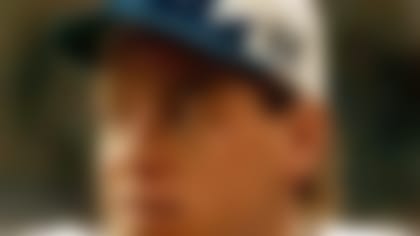Leonard Marshall creaming Joe Montana in the 1990 NFC Championship Game. Jim Harbaugh's Hail Mary rolling off his receiver's belly. Desmond Howard taking it to Bill Parcells' Patriots -- and to the house. Garrison Hearst's 96-yard rumble to help the 49ers win their '98 season-opener. The Titans coming one Mike Jones tackle short of ruling the NFL.
Yep, those were some of the plays of the BY2K era, the '90s. All of them are recognizable in their own way, yet none of them make our list of the top plays of the decade.
What gives?
Debate: QB-WR duos of the '90s

The '90s were dominated by pitch-and-catch combos like Troy Aikman and Michael Irvin. Which was the best? Let's debate! **READ**
It's simple; the decade that provided us with Luke Perry's glorious 'do, Veronica's Closet, and the greatest outgoing answering machine message ever didn't short-change football fans when it came to thrilling plays. The era was packed with some elite teams, from the Dallas Cowboys to the Denver Broncos, and yes, even the Lombardi Trophy-less Buffalo Bills. You will find them all represented below.
Before diving into the top five plays of the 1990s, be mindful that the moments below are those that we thought of as the signature moments of a decade that also introduced free agency and the salary cap. With that, feel free to share your thoughts about which plays belong ... @HarrisonNFL is the place.
Speaking of free agency, let us start with a play that came from the last year teams actually got to keep all their players ...
5) Harper's sprint
When Jimmy Johnson became coach of the Dallas Cowboys in 1989, expectations were nil, especially as many of the veterans from the Tom Landry era were let go. Johnson, however, had a plan, and within three years, his team was a certifiable contender, compiling a 13-3 record in 1992 and making it to the NFC Championship Game.
Enter San Francisco ... Which is exactly what the Cowboys had to do, as the Niners were hosting the game at Candlestick Park, the very site of the NFC title match played 11 years prior -- between these very same teams -- that launched a 49ers dynasty, courtesy of Dwight Clark and "The Catch." But there would be no theatrics from San Francisco receivers on this day; a back-and-forth affair developed, with the explosive San Francisco offense and the Cowboys' attack both held somewhat in check.
Still, Dallas had a 24-20 lead late in the fourth quarter, having put together two strong second-half touchdown drives. At the three-minute mark, the Cowboys found themselves with a first-and-10 at their own 20, and Johnson, knowing the Niners had all three of their timeouts left, had a decision to make: run the ball and force San Francisco to burn one, or do something aggressive -- but risk stopping the clock with an incomplete pass.
Cowboys offensive coordinator Norv Turner asked Johnson over the headset what he wanted to do, and the answer was clear: "I want to score."
So Turner called "896 F Flat," which included a slant on the backside. Star wideout Michael Irvin was supposed to line up on that side of the formation, but he opted to go to the other side, because Dallas had run this play a couple of times before, and quarterback Troy Aikman had gone that way with the football.
Big mistake ... for Irvin, that is. Aikman noticed the Niners were showing blitz, which meant the football would need to go to the backside slant -- where Irvin would have been. Instead, Aikman delivered a perfect strike to Alvin Harper, Niners cornerback Dana Hall slipped and fell, and No. 80 in white was off to the races. Harper didn't go down until he'd covered 70 yards and set up the clinching score to launch a new dynasty.
4) Lett-down in Big D
After beating the Niners in that NFC title game, Dallas went on to clobber the Buffalo Bills in Super Bowl XXVII, 52-17. Of course, the final could have been 59-17 -- which would have set a record for points scored -- had it not been for Cowboys DT Leon Lett's infamous showboating inside the Bills' 5 on a fumble return.
You surely know that play: Lett sticks the ball out in all of his reserve-defensive-linemen-turned-ball-carrier-rumbling-to-the-end-zone glory, and Bills receiver Don Beebe strips it just shy of the goal line. That gaffe would have been a lock for this piece -- if only Lett hadn't outdone himself the following season.
The Cowboys' title defense had hit a midseason speed bump in Atlanta, in the form of a 27-14 loss that sent Dallas into a Thanksgiving Day home matchup against the Miami Dolphins with a 7-3 record. The contest was a struggle for both the Dolphins, who were without Dan Marino, and the Cowboys, who were dealing with a limited Emmitt Smith. A defensive battle ensued, and Dallas wound up clinging to a 14-13 advantage in the game's closing moments.
That's when Lett let his guard down. Again.
Marino fill-in Steve DeBerg had moved the Dolphins to within field-goal range on the snow-covered Texas Stadium carpet, setting up Pete Stoyanovich for a game-winning attempt with 18 seconds remaining. And the kick was ... blocked! Seeing the ball bouncing around near the goal line, Lett sprinted over to pounce on it, apparently unaware that doing so would make it live. Other Cowboys players were waving their arms and yelling, "Peter! Peter!" -- code for don't touch it. That's precisely when Lett came down like a water buffalo on a track of gum balls, barreling into the football and sending it careening out of reach.
Oops.
Lett could not be consoled after the game -- even Johnson, who was known to be hard on his guys following losses, tapped the brakes in this case. But this setback didn't stop the Cowboys from winning out the rest of the regular season, backing up Johnson's guarantee in the NFC title game and prevailing in their second trip to Atlanta -- in Super Bowl XXVIII.
3) The Helicopter
Little did anyone know, heading into Super Bowl XXXII, that the most-discussed topic of the 1997 postseason -- John Elway's legacy -- would be cemented by one run.
At that point, Elway was a franchise quarterback with a reputation for lifting the Broncos to victory at times when it seemed least likely, winning an NFL MVP award in 1987 and driving Denver to three previous Super Bowl appearances. But, like many great players before him -- Walter Payton and Joe Montana, included -- Elway had hit a lull. The Broncos had been bounced by the Jacksonville Jaguars in the previous year's playoffs, despite the presence of a roster that seemed poised to help Elway finally win it all, and he had entered the 1997 season -- his 15th -- without a ring.
A highly motivated leader (and organization) was left hungry to get it done. After making the playoffs as a wild-card squad, the Broncos took down the Jags, Kansas City Chiefs and Pittsburgh Steelers before running up against Brett Favre and the Green Bay Packers in the title game. Could Elway finally capture a Lombardi Trophy on his fourth try?
Super Bowl XXXII wound up being a classic, marked by lead changes, Denver running back Terrell Davis' ascension to superstar status and the Broncos stopping Favre when it counted. And, of course, it included the play that symbolized a career of honest effort: an 8-yard Elway scamper.
It was late in the third quarter, and the underdog Broncos were hanging with the defending champs, having scratched out a 17-17 tie. Elway was facing third-and-6 inside the red zone -- and he really wanted a touchdown. Everyone in Qualcomm Stadium -- including the 37-year-old signal-caller -- knew how explosive Favre and the Packers were. Denver needed seven points, not a field goal.
Operating out of the shotgun, Elway stepped up, then took off on a middle-aged dash for the sticks. Lunging for the first down, he wrote the kind of check that usually only 20-year-old bodies can cash. Two Packers absolutely creamed Elway, spinning him nearly 360 degrees in the air ... and he landed past the marker.
Elway raised a hand to the air, the crowd already in full-on "nutso" mode. Now the other 10 players in the Denver huddle were sure of how badly their quarterback wanted that elusive ring.
He would get it. Davis went on to score on a 1-yard plunge and the Broncos wound up with a 31-24 victory -- the first of two consecutive Super Bowl wins.
2) Music City Miracle
Not even the most amazing writing can adequately capture the chaos that erupted at the end of a 1999 playoff game between the Buffalo Bills and Tennessee Titans. The play that decided that wild-card bout still defies belief.
Of course, one likely wouldn't have predicted such a finish to what was, for much of its run time, a rather mediocre affair. The news of the day was Bills coach Wade Phillips' decision to start Rob Johnson over fan-favorite Doug Flutie at quarterback. And if Buffalo supporters thought they were getting the short end of the stick with the taller but less effective Johnson, well ... they would sure feel short-changed a bit later.
Don't blame Johnson, though, who actually completed two key throws to set up Steve Christie's go-ahead field goal, which gave the Bills a 16-15 lead with 16 seconds left. Because then Wycheck happened.
On the ensuing kickoff, Christie, as he had been ordered to do from the sideline, executed a perfect squib kick, which floated right to Titans "up man" Lorenzo Neal, who had a better shot of dropkicking the ball through the goal posts then taking it all the way. Neal turned and handed it to Frank Wycheck, which was like a snail handing it to a slightly faster snail (at least in terms of kick-return speed). Tennessee's shot seemed to be about one-in-a-thousand. Until Wycheck shot-put the ball across the field ...
... and into the waiting arms of speedy wideout Kevin Dyson, who had a whole lot of blockers and a whole lot of grass in front of him. Dyson coasted 75 yards to the house.
To thousands in the stadium and millions watching at home, Wycheck's heave looked like a forward pass. If ever a play was splitting hairs, this was it. The ruling on the field deemed it legal, so, next up ... instant replay. Referee Phil Luckett went under the hood and conferred for what seemed an eternity -- ABC had us gaze 196 times at the position of Dyson's feet and the exact trajectory the ball took upon leaving Wycheck's hand -- before making his decision: inconclusive.
Call it the zaniest play to decide a football game since Cal stunned Stanford in '82. The Titans would go on to Super Bowl XXXIV, where the football gods stopped them 1 yard short of another miracle.
As for the Bills, they haven't been back to the postseason since. Maybe Zeus was a Flutie fan.
1) Wide Right
Pro football's version of "The Shot Heard 'Round the World" is slightly different from Bobby Thomson's 315-foot blast to win the National League pennant in 1951. Bills kicker Scott Norwood's errant boot in Super Bowl XXV was from just 141 feet out, yet its reach can still be felt more than 23 years after it was attempted.
Never has a missed field goal created such a stir as "Wide Right." Yes, the inopportune push that came at the worst possible time -- something to which only the Greg Normans of the world can relate -- marred the Bills' first Super Bowl appearance. But understand this: Norwood's miss is only famous because the game -- a fantastic title tilt between Bill Parcells' Giants and the K-Gun Bills -- was as good as any Super Sunday ever was, and maybe ever will be. That, as much as the stakes, is what makes this play so memorable.
New York was clutching oh-so-tightly to a 20-19 fourth-quarter lead. Those in the crowd, already wound up from the country's involvement in the Gulf War and Whitney Houston's stirring rendition of the national anthem, had gotten more than their $500 worth from this baby. As Jim Kelly drew the Bills closer, driving Buffalo 61 yards in eight plays, the masses in Tampa Stadium knew that maybe the best game they had ever seen in person was coming down to a kicker from James Madison. And on second-and-10 with eight seconds remaining and the Bills on Big Blue's 29, Buffalo coach Marv Levy made the call for Norwood. It would be a 47-yard try, on grass -- no chip shot.
It's worth remembering that in a tight match like that, no single play truly decides the result. For that matter, Norwood had successfully decided many a football game in previous seasons. Besides making several clutch kicks, Norwood had been an All-Pro just two years prior, in 1988.
Of course, the amount of time that had elapsed since then probably felt more like 200 years as Norwood lined up for his fateful attempt. He looked like a man cramming for the SATs while he made his paces. The ball was spotted. Snap good, hold right, Norwood hit it true ...
Wide right.
The legacy of Parcells was sealed. The Bills didn't realize theirs would soon be as well, with three subsequent Super Bowl losses to follow.
Would a Norwood make have changed everything? Maybe, maybe not. To this day, though, the words "wide right" make people think of Norwood's miss.
Follow Elliot Harrison on Twitter @HarrisonNFL.












